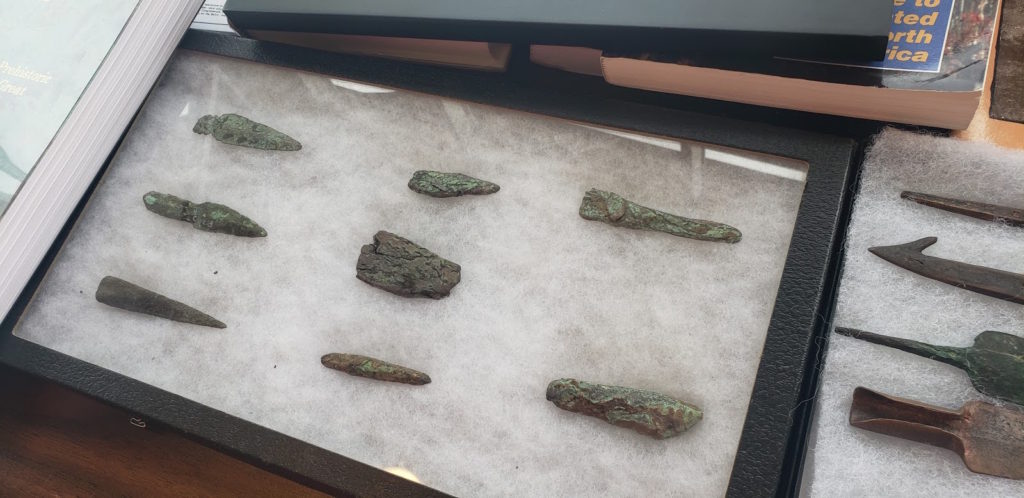The Marquette Regional History Center (MRHC) returned with its annual Archaeology Fair on Saturday, Oct. 19, International Archaeology Day. A total of 16 booths weaved throughout the center, upstairs and even outdoors and vendors shared their historical collections, bringing the past to the present.
The booths included topics such as discovering “How Old is that Bottle,” uncovering the secrets of Isle Royale National Park and “Archaeology of the Viking World.”
“The more we can learn about where an artifact is located and what other possible artifacts and features are at the same location, the more we can discover its story and possibly fill in missing pieces of history,” according to an archaeology poster displayed at the center of the MRHC. “If you live in the U.P., there’s a good chance you will find an artifact. But before you pick it up and put it in your pocket, remember that there is a story behind every artifact and that story can be lost if proper steps are not taken.”
Author Larry Buege represented his booth called “Pre-Columbian Survival Skills.” Slabs of wood laid on the table with sticks in varying places depending on the design of its trap. A tupperware container was filled with black, curly “Rock Tripe,” a nutritional-value lichen. Ziplock bags were filled with ground acorns, wild rice and maple seeds, all ready to be shown off for their debut.
First, Buege showed the significance of each trap. There was the Whip Snare with a hook release, a Simple Snare for non-chewing animals like ducks and an Ojibway Bird Pole for small birds.
Next, Buege talked about how rice and acorns could be eaten if treated correctly. For example, after harvesting wild rice in early September, the rice parched (roasted) to loosen the inedible hulls. It’s then tossed gently in the air so the wind will separate the lighter hulls from the rice, and it keeps for long periods when dry, he explained.
“I enjoy talking about this,” Buege said, and he’s looking forward to being invited back for future archeology events at the center.
Buege’s novels, some displayed behind him, reflect what he’s learned from archeology and life in general. He also has available free award-winning short stories for those that want to discover more.
NMU made its appearance at the center through the university’s Anthropology Club with booths that covered methods of Forensics Research Outdoor Station (FROST) as well as “Projectile Points and Pottery.”
Bob Wheeler, the booth owner of “Ancient Use of Copper in the Lake Superior Region,” was present to share his collection of archaeological weapons and tools—both real and remade—and explained the stages of production that copper transitions from into an artifact.
“This was the first use of metal in the world, and it’s not well known,” Wheeler said. “It’s really amazing.”
Though some of these knives and tools have been in the ground and rusting away for thousands of years, they trade for a significant price, Wheeler said.
“These go for big money. They’re sold as authentic and they’re not,” Wheeler said. “Some years ago, they figured $100 an inch. So 5 inches is $500. That’s real money.”
Back in the day, farmers found artifacts and stored big collections that would eventually end up in museums, Wheeler explained, but for the past 30 to 40 years, finding artifacts has been done with the use of metal detectors and, because of this, people are able to find more now, mostly in Wisconsin.
“There’s a problem with that. Archaeologists don’t like metal detectors. If you’re on your own property or you have permission from the land owner, then it’s legal. You can do that,” Wheeler said. “But too many of them are just out in the woods, they don’t know who’s property they’re on, they don’t care who’s property they’re on, they find something of value and walk away with it. It’s what we’ve [now] lost for knowledge.”
So if you happen to find an artifact, the MRHC is a great place to start. They can help and their staff has professional resources that can point you in the right direction.
There are laws that govern the disturbance of archaeological sites, the sale of artifacts and their movement across state and international borders, according to the MRHC. To determine what laws might affect a U.P. artifact, visit www.michigan.gov/archaeology.com























